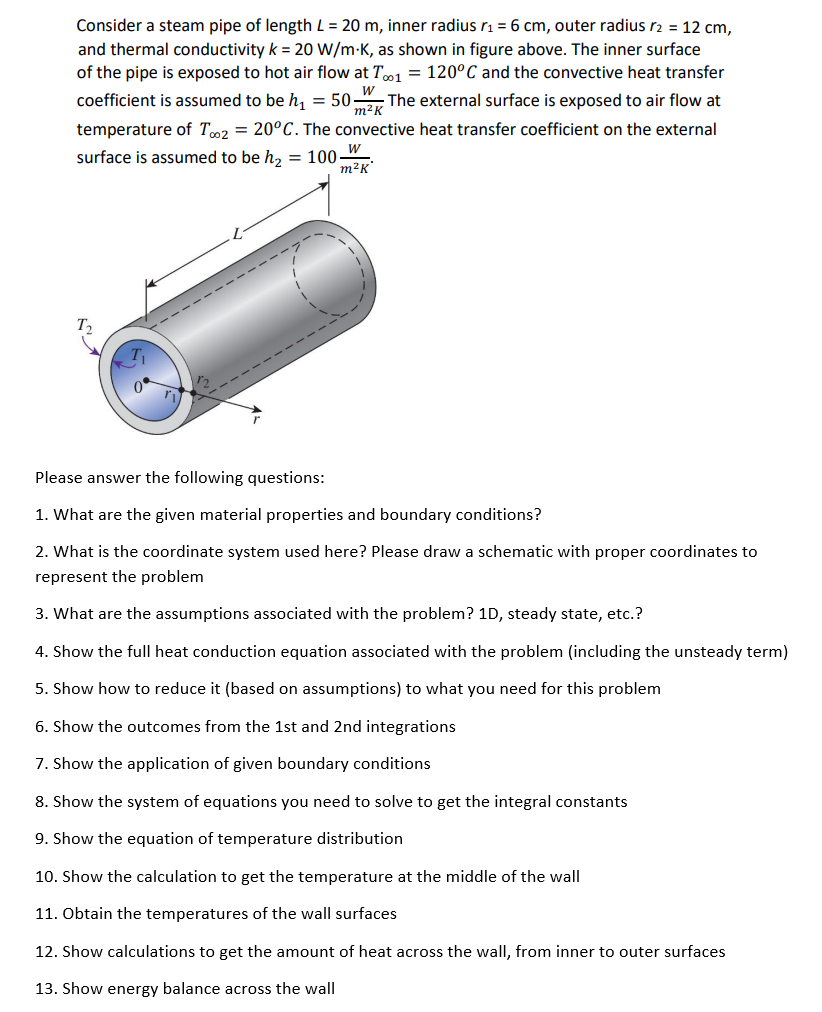Consider a steam pipe of length L = 20 m, inner radius r₁ = 6 cm, outer radius r₂ = 12 cm, and thermal conductivity k = 20 W/m-K, as shown in figure above. The inner surface of the pipe is exposed to hot air flow at T1 = 120°C and the convective heat transfer coefficient is assumed to be h₁ = 50 The external surface is exposed to air flow at temperature of Too2 = 20°C. The convective heat transfer coefficient on the external surface is assumed to be h₂ = 100. W m²K W m²K Please answer the following questions: 1. What are the given material properties and boundary conditions? 2. What is the coordinate system used here? Please draw a schematic with proper coordinates to represent the problem 3. What are the assumptions associated with the problem? 1D, steady state, etc.? 4. Show the full heat conduction equation associated with the problem (including the unsteady term) 5. Show how to reduce it (based on assumptions) to what you need for this problem 6. Show the outcomes from the 1st and 2nd integrations 7. Show the application of given boundary conditions 8. Show the system of equations you need to solve to get the integral constants 9. Show the equation of temperature distribution 10. Show the calculation to get the temperature at the middle of the wall 11. Obtain the temperatures of the wall surfaces 12. Show calculations to get the amount of heat across the wall, from inner to outer surfaces 13. Show energy balance across the wall
Consider a steam pipe of length L = 20 m, inner radius r₁ = 6 cm, outer radius r₂ = 12 cm, and thermal conductivity k = 20 W/m-K, as shown in figure above. The inner surface of the pipe is exposed to hot air flow at T1 = 120°C and the convective heat transfer coefficient is assumed to be h₁ = 50 The external surface is exposed to air flow at temperature of Too2 = 20°C. The convective heat transfer coefficient on the external surface is assumed to be h₂ = 100. W m²K W m²K Please answer the following questions: 1. What are the given material properties and boundary conditions? 2. What is the coordinate system used here? Please draw a schematic with proper coordinates to represent the problem 3. What are the assumptions associated with the problem? 1D, steady state, etc.? 4. Show the full heat conduction equation associated with the problem (including the unsteady term) 5. Show how to reduce it (based on assumptions) to what you need for this problem 6. Show the outcomes from the 1st and 2nd integrations 7. Show the application of given boundary conditions 8. Show the system of equations you need to solve to get the integral constants 9. Show the equation of temperature distribution 10. Show the calculation to get the temperature at the middle of the wall 11. Obtain the temperatures of the wall surfaces 12. Show calculations to get the amount of heat across the wall, from inner to outer surfaces 13. Show energy balance across the wall
Principles of Heat Transfer (Activate Learning with these NEW titles from Engineering!)
8th Edition
ISBN:9781305387102
Author:Kreith, Frank; Manglik, Raj M.
Publisher:Kreith, Frank; Manglik, Raj M.
Chapter2: Steady Heat Conduction
Section: Chapter Questions
Problem 2.38P:
2.38 The addition of aluminum fins has been suggested to increase the rate of heat dissipation from...
Related questions
Question

Transcribed Image Text:Consider a steam pipe of length L = 20 m, inner radius r₁ = 6 cm, outer radius r₂ = 12 cm,
and thermal conductivity k = 20 W/m-K, as shown in figure above. The inner surface
of the pipe is exposed to hot air flow at T1 = 120°C and the convective heat transfer
coefficient is assumed to be h₁ = 50 The external surface is exposed to air flow at
temperature of Too2 = 20°C. The convective heat transfer coefficient on the external
surface is assumed to be h₂ = 100-
W
m²K
W
m²K
Please answer the following questions:
1. What are the given material properties and boundary conditions?
2. What is the coordinate system used here? Please draw a schematic with proper coordinates to
represent the problem
3. What are the assumptions associated with the problem? 1D, steady state, etc.?
4. Show the full heat conduction equation associated with the problem (including the unsteady term)
5. Show how to reduce it (based on assumptions) to what you need for this problem
6. Show the outcomes from the 1st and 2nd integrations
7. Show the application of given boundary conditions
8. Show the system of equations you need to solve to get the integral constants
9. Show the equation of temperature distribution
10. Show the calculation to get the temperature at the middle of the wall
11. Obtain the temperatures of the wall surfaces
12. Show calculations to get the amount of heat across the wall, from inner to outer surfaces
13. Show energy balance across the wall
Expert Solution
This question has been solved!
Explore an expertly crafted, step-by-step solution for a thorough understanding of key concepts.
Step by step
Solved in 3 steps with 4 images

Knowledge Booster
Learn more about
Need a deep-dive on the concept behind this application? Look no further. Learn more about this topic, mechanical-engineering and related others by exploring similar questions and additional content below.Recommended textbooks for you

Principles of Heat Transfer (Activate Learning wi…
Mechanical Engineering
ISBN:
9781305387102
Author:
Kreith, Frank; Manglik, Raj M.
Publisher:
Cengage Learning

Principles of Heat Transfer (Activate Learning wi…
Mechanical Engineering
ISBN:
9781305387102
Author:
Kreith, Frank; Manglik, Raj M.
Publisher:
Cengage Learning